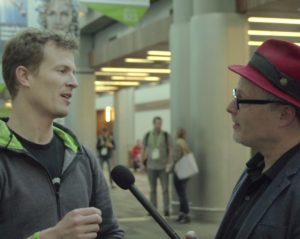 In this video from the NVIDIA GPU Technology Conference, Ryan Olson from NVIDIA describes how containers for HPC can streamline workflows on the NVIDIA GPU Cloud.
In this video from the NVIDIA GPU Technology Conference, Ryan Olson from NVIDIA describes how containers for HPC can streamline workflows on the NVIDIA GPU Cloud.
“There are so many reasons why you’d want to move to a container. Containers just make life easy. They really do. So one of the things that people have issues with running bare metal is from time to time their libraries change, maybe they want to try the new version of CUDA, the new version of cuDNN, and they forget to simlink it back to the original path. If you have packaged your app into a container, it’s the same every time. Whatever’s in the container, is in the container.”
Transcript:
insideHPC: Hi, I’m Rich with insideHPC. We’re here at the GPU Technology Conference in Silicon Valley, and I’m here with Ryan from Nvidia. Ryan, we’re here today to talk about containers. And when people have a workflow they’re kind of used to going on their merry way, running on bare metal. Why would I want to move to a container?
Ryan Olson: There are so many reasons why you’d want to move to a container. Containers just make life easy. They really do. So one of the things that people have issues with running bare metal is from time to time their libraries change, maybe they want to try the new version of CUDA, the new version of cuDNN, and they forget to simlink it back to the original path. If you have packaged your app into a container, it’s the same every time. Whatever’s in the container, is in the container.
insideHPC: Okay. And when I thought of containers before, I thought it was just because we were moving to the cloud, but you do this locally as a first step, don’t you?
Ryan Olson: Absolutely. You start local. Taking the app that you’re used to running bare metal and just move it into a container. That’s it. Move it into the container, run it again, make sure it still works. As soon as you put it in the container, now you’re ready to go the cloud, you’re ready to go off to a different developer. It doesn’t matter. You can ship it anywhere you want after that.
insideHPC: Okay, okay, so it’s not just about portability, then, it’s about reproducibility, it sounds like.
Ryan Olson: Reproducibility is the name of the game. When you build that container, it is like a time capsule. It is frozen in time, and that’s your fundamental reproducibility.
insideHPC: And we were talking earlier about you’ve basically turned Red Hat into kind of like a Mac, you just double-click the app. It’s like magic, isn’t it?
Ryan Olson: It’s very much like magic. Kind of the stuff that goes around the covers, there’s a little bit of stuff getting used to on how you launch it, how you get into it, but once you get the hang of it, it becomes quite magical.
insideHPC: Okay. So kind of a wrap-up question here, Ryan. Where is this going? I mean, you just going to keep improving on performance, or where’s your focus?
Ryan Olson: Well, the first thing that has to happen is you have to go to your sysadmin and make sure that you have an appropriate container run-time available on your system. So once that’s in place, then the users are free to go to NGC and download the latest and greatest HPC containers from our NVIDIA GPU Cloud registry. Given that, you pull those containers and then follow the instructions, and like I said earlier, it’s kind of like magic.
insideHPC: Well, you’re off to the races. Thanks for sharing that with us.




